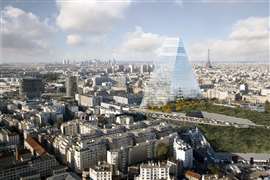Why has Paris reimposed a ban on tall buildings?
08 June 2023
 Digital rendering of the Tour Triangle, Paris (Image: Herzog & de Meuron)
Digital rendering of the Tour Triangle, Paris (Image: Herzog & de Meuron)
The French city of Paris has reimposed a ban on tall buildings in a bid to preserve its low-rise skyline.
Paris’s city council voted in favour of limiting the height of new buildings to 37 metres earlier this week.
The city has adopted a new ‘Plan Local d’Urbanisme’ (PLU), which its supporters claim will promote more environmentally friendly construction in the local area.
Paris has long fought to remain a low-rise city. While it does have taller buildings in its La Défense business district in the western suburbs, as well as taller residential blocks in the 13th and 15th arrondissements, the centre of Paris is largely free of tall buildings.
It introduced a height limit for new buildings of 37 metres in certain parts of the city back in the 1970s after the construction of the 209m-tall Montparnasse Tower office building, which was completed in 1973.
Some Parisians criticised the monolithic tower for being out of place in the Paris landscape.
More recently, in 2010, regulations changed to allow residential towers up to a maximum of 50m in height and 180m for offices in certain areas outside of the city centre (where there have long been limits of 31m, 25m or even 18m, depending on the area).
The changes to the rules came as the city’s administration of the time vied to compete with London, which has seen a glut of tall buildings constructed in recent times, including the 310m-tall The Shard, completed in 2013, and the 224m-tall Leadenhall Building completed in 2014.
But the commencement last year of the construction of the 180m-tall Tour Triangle reignited the debate around tall buildings’ place in the French capital once again.
The Tour Triangle, designed by architect Herzog & de Meuron and being built by main contractor Besix, was the first skyscraper to be built in the centre of Paris since Montparnasse Tower’s construction.
The project won a building permit in 2015 but faced two legal appeals before finally getting the go-ahead in 2019.
Now the city council, led by Socialist party mayor Anne Hidalgo, has reimposed the 37m limit, partly in response to the Tour Triangle’s construction.
Debate over environmental performance of tall buildings
Supporters put forward an ecological argument for the change, arguing that it is harder to build buildings designed to bioclimatic principles if they are above 30m in height because of the amount of energy the buildings consume moving people and services like water around the building.
Nonetheless, the new regulations do allow for higher elevations in some parts of the city where lower limits were previously applied. These allow for the construction of buildings up to a height of 37m but only if they are residential and in streets whose width is greater than 12m.
While the proponents of the new PLU argued that tall buildings consume more energy and their carbon footprint is less good, others questioned the move.
Engineer Franck Boutté, who won the Grand Prix de l’Urbanisme from the French government in 2022 told French media outlet 20 Minutes that comparing the environmental performance of tall buildings to their shorter counterparts was a more complex exercise than it first appeared.
He said, “You need to compare comparable objects. If you compare a 60m-tall building with a 30m-tall building, obviously you need more materials for the 60m-tall building but in fact you should be comparing the 60m-tall building with two 30m-tall buildings.”
“There are lots of myths on the question of height but no serious scientific studies on the subject,” he added.
Some in the engineering profession have argued that in order to maintain green spaces in the city without reducing density, building upwards makes sense.
But supporters of the PLU among the Écologistes party argued that the new regulations were an opportunity to remake and renovate existing buildings, to make construction “the exception” in favour of transformation.
STAY CONNECTED



Receive the information you need when you need it through our world-leading magazines, newsletters and daily briefings.
CONNECT WITH THE TEAM








